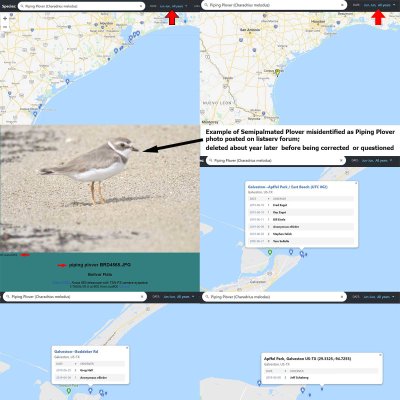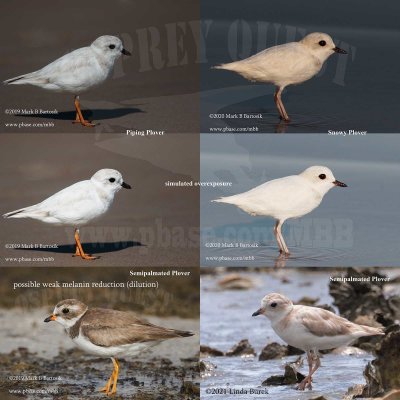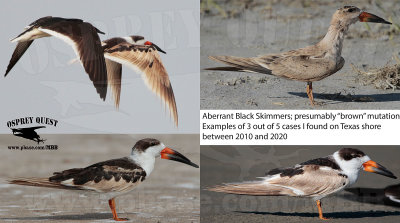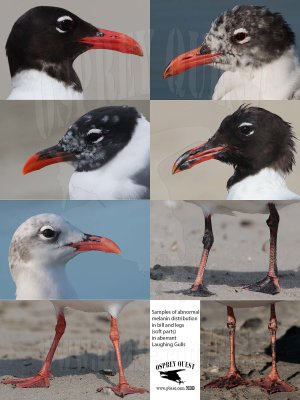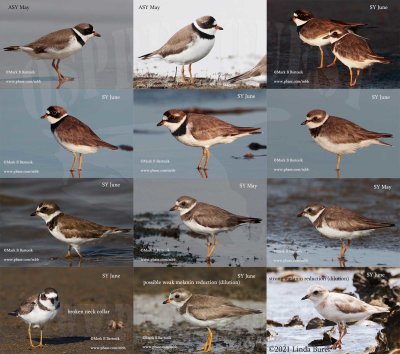Mark B Bartosik
Well-known member
Hi All,
Not quite about seabirds but it is about shorebirds so it is about birdlife on the edge of the sea.
After a decade of chasing Piping Plover along Texas shore from Louisiana to Mexico border, I am convinced that June records in this area are extremely rare. I only found two Piping Plovers during June in Texas. And I am looking for these birds often exclusively. I am hoping that perhaps somebody from the eBird team will investigate this problem and will remove all unverified records (without photos or band records) at least from the public display of database records. BTW I remember I posted a similar request several years ago about winter records of Least Tern and seems that somebody checked it and took a serious approach as those records are not publicly visible now. Personally, it makes no difference to me (I do not depend on eBird records for my study at all) but it will improve the database for those who are looking for reliable records.
As one can check PIPL records in the eBird database, historically, there is a lot of them during June on the Texas shore. Only a very few have enough information (for example bands description) or photo attached that can be verified and confirm the sighting. The rest (the vast majority) of them, as I will explain later, are most likely SY over summering Semipalmated Plovers. I would imagine that eBird's goal is to provide as accurate as possible data sets for all species. Providing maps that show unverified and most likely wrong dates is sending many birders on the goose chase and also is providing a false background for somebody not familiar with these species (PIPL and SEPL) to assume that if other people found them there so what they saw must be a PIPL. As you can check on the attached maps, especially in June 2019 there was an explosion of sightings on Galveston Island and Bolivar Peninsula (a place I was visited then weekly or biweekly). Again, I assume that many birders after seeing those records posted on eBird (or posted on Texas listserv) were expecting Piping Plovers to be there and of course ‘found’ them as well. Perhaps one who is confident in identifying both species might think that only ‘rookie’ will enter SEPL as PIPL. Unfortunately, it seems that even well-known birders (that often are seen as authorities) can be tricked. This photo of SEPL was posted as PIPL rare summer sighting in June of ‘famous’ 2019 on the listserv. So perhaps no surprise that so many people have seen PIPL that June.
This photo was later (a year later?) removed but I did not recall any correction before removal posted on the listserv but I do not check it often or read all messages.
Very pale SEPLs are rare but I have seen a few - it seems that perhaps melanin reduction (dilution) maybe not be super rare but in some cases, it will be difficult to distinguish mutant from a bleached bird.
Perhaps the most interesting individual was one found recently (June 2021) in Florida by Linda Burek. Originally posted as PIPL (on eBird and iNaturalist) but ID now is corrected after I sent the note. Also, this ID was corrected on eBird as well. I do have a permit from Linda to post her photo on my site.
So here, for those who are interested, I put together a few composites.
Examples of melanin reduction (dilution) in small plovers. I found this chromatic aberration in PIPL, SNPL, and SEPL (but Linda's sample is the most interesting case of aberrant SEPL). I also included an illustration of what will happen if somebody just slightly overexposes the pale bird (happens quite often judging by photos posted on the web) it will appear white and even more surely it will be reported as ‘’leucistic”.
BTW when searching for birds’ color mutations in most cases melanin reduction mutations are lumped with other abnormally white or pale birds as either leucistic or partially leucistic birds (before used to be albinos or "partial" albinos). As chromatic aberrations in birds seem to be very poorly studied (except perhaps chickens and domestic pigeons) I was never able to find broadly accepted descriptions or definitions of the majority of mutations.
As this post subject is primarily about small plovers and ID problems with aberrant individuals, I will not discuss in too many details cases of similar mutations in other birds I found in wild. This is usually not triggering too much interest or yielding too many responses anyway. But I am always interested if somebody has data or suggestions to discuss. I have a few examples of abnormal “pale” plumage uploaded here if somebody care to see it Most of these birds will have difficulty surviving in the wild and for example, Black Skimmers will have difficulty controlling flight when skimming –Feathers with reduced melanin are extremely bleached very quickly and as shown in photos becoming wear out very badly.
or interesting bill coloration abnormalities
I was asked before by those who know about my interest in small plovers if I can illustrate SY SEPL in summer. Finally, I put together an illustration to show variations one will find in SEPL SY birds. From adult-like in alternate plumage (small number) to most common (center photos) with mixed black and brown feathers in neck collar (at different proportions) to completely brown neck collar and head feathers (no black alternate feathers on head and neck or pigment reduction). Note that always (so far) SY will have (all specimens were found in Texas) almost or completely black top part of the upper mandible. ASY, as shown for comparison usually will have all orange base parts of the bill proximal to the gape at the peak of the breeding season. Added are pale/dilution plumage examples as well.
No space or time to discuss that here but SEPLs (based on speculations in printed material) might show not only the most interesting molt strategies (from all other small plovers found in Texas) but also the most interesting variety of mutations including head patterns and chromatic aberrations including hypermelanism (much darker plumage with the bill either all black or with very dark maroon base) and perhaps the most interesting individual I found was one with very dark (melanistic?) plumage mixed with white feathers on head and body. To my best knowledge, only a few cases like that were recorded in published papers. Perhaps somebody has more information on this subject. SNPL also can sport very interesting head patterns and what is more interesting black feathers on the breast and black feathers between two neck patches (hint of perhaps neck collar in the past?, atavism?).
Despite seeing (and photographing almost all of them) several thousand PIPL sightings presented mutant was the only bird showing color abnormalities from normal plumage variations on the Texas shore. Perhaps two more individuals were quite interesting – one SY bird showing fault growth bars on all flight feathers (primaries, secondaries, wing coverts, and tail feathers). Could not find any published data about how often this occurs in this species if ever recorded. As this phenomenon is usually triggered by stress/food deficiencies it is another cup of tea. As is also a case (also one) of PIPL with supernumerary (extranumerary) primary in one wing, 11 primaries. Does anybody know if this was recorded in another PIPL before?
Perhaps if somebody made to this point of my post there is a chance that he/she has an interest in SEPL molt as well. As stated above I spent a few years studying PIPL molt in banded individuals. In all these years I did not find even one banded SEPL here (Texas). I also do not plan to visit South America anytime soon so perhaps someone has information I need to find out as I want to have a better understanding when comparing molt strategies between these two species (SEPL and PIPL). So what I found about preformative SEPL molt. There are no published records I could find about either full preformative or eccentric molt. The newest revision BOTW (2020) went into the length to describe eccentric molt in SEPL but there are absolutely no references included, except Pyle (2008) who in his book suggest that eccentric pp molt might occur in SEPL but as well, offer no known examples or references but he rather direct to a general chapter in his book about molt in shorebirds.
Then there is this vagrant SEPL record in Australia that was accepted and in the memorandum (Memorandum to:) this note was included:
Moult. The timing of primary moult differs between juvenile Semipalmated Plover and juvenile Ringed Plover. The literature states that Semipalmated Plover are not known to moult juvenile primaries until their second prebasic moult when about a year old (Cramp and Simmons 1983). In contrast, first year Ringed Plovers of subspecies tundrae replace their primaries in a pre-formative moult from March-May of their second calendar year. The timing of primary moult in the Broome bird in 2009-2010 was therefore unexpected given all other features were pointing toward the bird being a Semipalmated Plover. This observation was discussed with several moult experts. Peter Pyle confirmed that pre-formative moult of all primaries has not been recorded in Semipalmated Plover before. However, he agreed that the Broome bird was a Semipalmated Plover. He noted that in American shorebirds in general, complete pre-formative moults become increasingly more common the further south they migrate. He also noted that the published information available on Semipalmated Plovers from the Americas is based on birds on northward passage through North America. He agreed with the suggestions of Danny Rogers that complete pre-formative primary moult in 'southern' Semipalmated Plovers in the Americas could have been overlooked because: (1) such birds may remain in the southern hemisphere for their first year of life (as occurs in many shorebird species in Australia), and thus be absent from samples of birds of north-bound birds in North American and; (2) after completing moult, such birds would be extremely difficult to distinguish from full adults”.
But I see no follow-up – it seems that nothing was published afterward, no documentation (photographs) illustrating the molt were included in the final report. I contacted few authors and Adrian Boyle sent me the draft of the submission report with photos illustrating postjuvenile (preformative) primary molt in this Australian SY SEPL vagrant. Thanks, Adrian.
From all replies, I will appreciate the most any opinion or links to possible examples of SEPLs replacing primaries during their preformative molt.
Best regards,
Mark
Not quite about seabirds but it is about shorebirds so it is about birdlife on the edge of the sea.
After a decade of chasing Piping Plover along Texas shore from Louisiana to Mexico border, I am convinced that June records in this area are extremely rare. I only found two Piping Plovers during June in Texas. And I am looking for these birds often exclusively. I am hoping that perhaps somebody from the eBird team will investigate this problem and will remove all unverified records (without photos or band records) at least from the public display of database records. BTW I remember I posted a similar request several years ago about winter records of Least Tern and seems that somebody checked it and took a serious approach as those records are not publicly visible now. Personally, it makes no difference to me (I do not depend on eBird records for my study at all) but it will improve the database for those who are looking for reliable records.
As one can check PIPL records in the eBird database, historically, there is a lot of them during June on the Texas shore. Only a very few have enough information (for example bands description) or photo attached that can be verified and confirm the sighting. The rest (the vast majority) of them, as I will explain later, are most likely SY over summering Semipalmated Plovers. I would imagine that eBird's goal is to provide as accurate as possible data sets for all species. Providing maps that show unverified and most likely wrong dates is sending many birders on the goose chase and also is providing a false background for somebody not familiar with these species (PIPL and SEPL) to assume that if other people found them there so what they saw must be a PIPL. As you can check on the attached maps, especially in June 2019 there was an explosion of sightings on Galveston Island and Bolivar Peninsula (a place I was visited then weekly or biweekly). Again, I assume that many birders after seeing those records posted on eBird (or posted on Texas listserv) were expecting Piping Plovers to be there and of course ‘found’ them as well. Perhaps one who is confident in identifying both species might think that only ‘rookie’ will enter SEPL as PIPL. Unfortunately, it seems that even well-known birders (that often are seen as authorities) can be tricked. This photo of SEPL was posted as PIPL rare summer sighting in June of ‘famous’ 2019 on the listserv. So perhaps no surprise that so many people have seen PIPL that June.
This photo was later (a year later?) removed but I did not recall any correction before removal posted on the listserv but I do not check it often or read all messages.
Very pale SEPLs are rare but I have seen a few - it seems that perhaps melanin reduction (dilution) maybe not be super rare but in some cases, it will be difficult to distinguish mutant from a bleached bird.
Perhaps the most interesting individual was one found recently (June 2021) in Florida by Linda Burek. Originally posted as PIPL (on eBird and iNaturalist) but ID now is corrected after I sent the note. Also, this ID was corrected on eBird as well. I do have a permit from Linda to post her photo on my site.
So here, for those who are interested, I put together a few composites.
Examples of melanin reduction (dilution) in small plovers. I found this chromatic aberration in PIPL, SNPL, and SEPL (but Linda's sample is the most interesting case of aberrant SEPL). I also included an illustration of what will happen if somebody just slightly overexposes the pale bird (happens quite often judging by photos posted on the web) it will appear white and even more surely it will be reported as ‘’leucistic”.
BTW when searching for birds’ color mutations in most cases melanin reduction mutations are lumped with other abnormally white or pale birds as either leucistic or partially leucistic birds (before used to be albinos or "partial" albinos). As chromatic aberrations in birds seem to be very poorly studied (except perhaps chickens and domestic pigeons) I was never able to find broadly accepted descriptions or definitions of the majority of mutations.
As this post subject is primarily about small plovers and ID problems with aberrant individuals, I will not discuss in too many details cases of similar mutations in other birds I found in wild. This is usually not triggering too much interest or yielding too many responses anyway. But I am always interested if somebody has data or suggestions to discuss. I have a few examples of abnormal “pale” plumage uploaded here if somebody care to see it Most of these birds will have difficulty surviving in the wild and for example, Black Skimmers will have difficulty controlling flight when skimming –Feathers with reduced melanin are extremely bleached very quickly and as shown in photos becoming wear out very badly.
or interesting bill coloration abnormalities
I was asked before by those who know about my interest in small plovers if I can illustrate SY SEPL in summer. Finally, I put together an illustration to show variations one will find in SEPL SY birds. From adult-like in alternate plumage (small number) to most common (center photos) with mixed black and brown feathers in neck collar (at different proportions) to completely brown neck collar and head feathers (no black alternate feathers on head and neck or pigment reduction). Note that always (so far) SY will have (all specimens were found in Texas) almost or completely black top part of the upper mandible. ASY, as shown for comparison usually will have all orange base parts of the bill proximal to the gape at the peak of the breeding season. Added are pale/dilution plumage examples as well.
No space or time to discuss that here but SEPLs (based on speculations in printed material) might show not only the most interesting molt strategies (from all other small plovers found in Texas) but also the most interesting variety of mutations including head patterns and chromatic aberrations including hypermelanism (much darker plumage with the bill either all black or with very dark maroon base) and perhaps the most interesting individual I found was one with very dark (melanistic?) plumage mixed with white feathers on head and body. To my best knowledge, only a few cases like that were recorded in published papers. Perhaps somebody has more information on this subject. SNPL also can sport very interesting head patterns and what is more interesting black feathers on the breast and black feathers between two neck patches (hint of perhaps neck collar in the past?, atavism?).
Despite seeing (and photographing almost all of them) several thousand PIPL sightings presented mutant was the only bird showing color abnormalities from normal plumage variations on the Texas shore. Perhaps two more individuals were quite interesting – one SY bird showing fault growth bars on all flight feathers (primaries, secondaries, wing coverts, and tail feathers). Could not find any published data about how often this occurs in this species if ever recorded. As this phenomenon is usually triggered by stress/food deficiencies it is another cup of tea. As is also a case (also one) of PIPL with supernumerary (extranumerary) primary in one wing, 11 primaries. Does anybody know if this was recorded in another PIPL before?
Perhaps if somebody made to this point of my post there is a chance that he/she has an interest in SEPL molt as well. As stated above I spent a few years studying PIPL molt in banded individuals. In all these years I did not find even one banded SEPL here (Texas). I also do not plan to visit South America anytime soon so perhaps someone has information I need to find out as I want to have a better understanding when comparing molt strategies between these two species (SEPL and PIPL). So what I found about preformative SEPL molt. There are no published records I could find about either full preformative or eccentric molt. The newest revision BOTW (2020) went into the length to describe eccentric molt in SEPL but there are absolutely no references included, except Pyle (2008) who in his book suggest that eccentric pp molt might occur in SEPL but as well, offer no known examples or references but he rather direct to a general chapter in his book about molt in shorebirds.
Then there is this vagrant SEPL record in Australia that was accepted and in the memorandum (Memorandum to:) this note was included:
Moult. The timing of primary moult differs between juvenile Semipalmated Plover and juvenile Ringed Plover. The literature states that Semipalmated Plover are not known to moult juvenile primaries until their second prebasic moult when about a year old (Cramp and Simmons 1983). In contrast, first year Ringed Plovers of subspecies tundrae replace their primaries in a pre-formative moult from March-May of their second calendar year. The timing of primary moult in the Broome bird in 2009-2010 was therefore unexpected given all other features were pointing toward the bird being a Semipalmated Plover. This observation was discussed with several moult experts. Peter Pyle confirmed that pre-formative moult of all primaries has not been recorded in Semipalmated Plover before. However, he agreed that the Broome bird was a Semipalmated Plover. He noted that in American shorebirds in general, complete pre-formative moults become increasingly more common the further south they migrate. He also noted that the published information available on Semipalmated Plovers from the Americas is based on birds on northward passage through North America. He agreed with the suggestions of Danny Rogers that complete pre-formative primary moult in 'southern' Semipalmated Plovers in the Americas could have been overlooked because: (1) such birds may remain in the southern hemisphere for their first year of life (as occurs in many shorebird species in Australia), and thus be absent from samples of birds of north-bound birds in North American and; (2) after completing moult, such birds would be extremely difficult to distinguish from full adults”.
But I see no follow-up – it seems that nothing was published afterward, no documentation (photographs) illustrating the molt were included in the final report. I contacted few authors and Adrian Boyle sent me the draft of the submission report with photos illustrating postjuvenile (preformative) primary molt in this Australian SY SEPL vagrant. Thanks, Adrian.
From all replies, I will appreciate the most any opinion or links to possible examples of SEPLs replacing primaries during their preformative molt.
Best regards,
Mark




